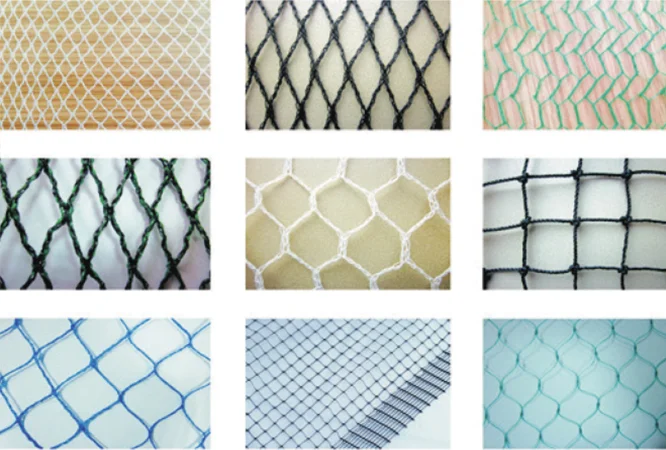- This topic is empty.
-
AuthorPosts
-
2025-02-14 at 2:02 pm #8695
Vineyards are essential for producing grapes, which in turn become the foundation of fine wines. However, one major challenge vineyard owners face is protecting their crops from birds that feast on ripening grapes. In this blog post, CANA, as high quality anti bird net manufacturer, will share the production process of warp knitted vineyard bird netting for sale, which combines durability, flexibility and effectiveness.
Understanding Warp Knitting
Warp knitting is a specialized textile manufacturing technique that differs from weft knitting. In warp knitting, yarns run parallel to the fabric' s length and are looped in a zigzag pattern to create a stable, stretch-resistant fabric. This method provides superior strength and durability, making it ideal for bird netting applications where resilience against environmental factors is crucial.
Production Process of Warp Knitted Vineyard Bird Netting
1. Selection of Raw Materials
The production of warp-knitted vineyard bird netting begins with the selection of high-quality raw materials. Typically, polyethylene (PE) or polypropylene (PP) is used due to their lightweight properties, UV resistance, and weatherproof capabilities. Some manufacturers incorporate additives like UV stabilizers and anti-oxidants to extend the netting' s lifespan under extreme weather conditions.
2. Extrusion of Filaments
Once the raw materials are chosen, they are melted and extruded into fine filaments using an extrusion machine. These filaments are then cooled and drawn to achieve the desired thickness and tensile strength. The quality of the filaments significantly affects the final product' s performance, making precision in this step essential.
3. Warping Process
The extruded filaments are wound onto beams in a process known as warping. This step ensures that the yarns are aligned correctly before they enter the warp knitting machine. Proper warping minimizes the chances of defects and enhances the overall consistency of the final netting.
4. Warp Knitting Process
The heart of the production lies in the warp knitting process. Warp knitting machines, equipped with multiple needles and guide bars, interloop the yarns in a controlled manner to create a strong and flexible netting structure. The knitting pattern used in vineyard bird netting generally features diamond or hexagonal shapes to provide maximum coverage while maintaining airflow and sunlight penetration.

5. Heat Setting and Stabilization
After knitting, the netting undergoes heat setting, a process where it is exposed to controlled heat to stabilize its structure. This step is crucial in preventing shrinkage, enhancing dimensional stability, and improving mechanical properties such as tensile strength and tear resistance. Heat setting ensures that the netting maintains its shape and functionality over time.
6. UV Treatment and Coating
Since vineyard bird netting is exposed to prolonged sunlight, it must be treated with UV stabilizers to prevent degradation. The netting may also be coated with additional protective layers to enhance resistance against moisture, chemicals, and physical wear. These treatments significantly extend the netting' s lifespan, ensuring long-term vineyard protection.
7. Cutting and Customization
Once the netting is fully processed, it is cut into various sizes according to customer specifications. Some vineyard nettings come with reinforced edges, grommets, or fastening accessories to facilitate installation and secure attachment to vineyard structures.
8. Quality Inspection and Packaging
Before shipping, the netting undergoes rigorous quality control checks to ensure it meets industry standards. Factors like mesh size uniformity, tensile strength, and UV resistance are assessed to confirm product reliability. After passing inspection, the netting is packaged in rolls or bales and prepared for distribution to vineyards worldwide.
Advantages of Warp Knitted Vineyard Bird Netting
The warp-knitting technique provides several advantages, making it an excellent choice for vineyard bird protection:
– High Strength & Durability: The interlocking loops create a sturdy netting that withstands high winds, heavy rainfall, and bird pecking.
– UV Resistance: Special UV stabilizers extend the netting' s lifespan, reducing the need for frequent replacements.
– Lightweight & Flexible: Despite its strength, warp-knitted netting remains lightweight, making it easy to install, remove, and store.
– Optimal Airflow & Light Penetration: The netting' s design allows proper ventilation and sunlight to reach the vines, ensuring healthy grape growth.
Conclusion
The production process of warp-knitted vineyard bird netting is a sophisticated and well-engineered method that ensures durability, strength, and functionality. By employing advanced materials, precise manufacturing techniques, and UV treatments, this netting effectively safeguards vineyards from bird damage while maintaining an optimal growing environment.
https://www.cananetting.com/Production-Process-of-Warp-Knitted-Vineyard-Bird-Netting.html
-
AuthorPosts
- You must be logged in to reply to this topic.